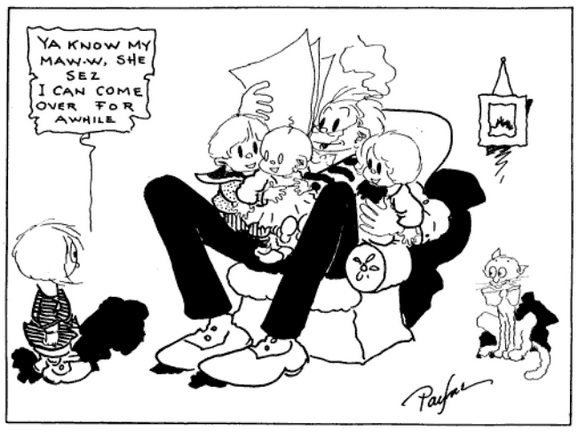|
C. M. Payne
Charles M. Payne (1873–1964) was an American cartoonist best known for his popular long-running comic strip ''S'Matter, Pop?''. He signed his work C. M. Payne and also adopted the nickname Popsy. In 1896, Payne was employed at the ''Pittsburgh Post''. ''Coon Hollow Folks'', his first comic strip, was followed by ''Bear Creek Folks'', ''Scary William'' and ''Yennie Yonson''. He created ''Honeybunch's Hubby'' (originally titled ''Mr. Mush''), for the ''New York World'',Holtz, Allan"Obscurity of the Day: Honeybunch's Hubby,"''Stripper's Guide'' (September 16, 2013). and in 1911, he drew ''Peter Pumpkin'' for ''The Philadelphia Inquirer''. His 1910 strip, ''Nippy's Pop'', was later retitled ''S'Matter, Pop?'' Initially carried by the Bell Syndicate, it ran from 1911 to 1940. During the 1920s, ''S'Matter, Pop?'' was a Sunday strip in the ''New York World'', followed by decades as a daily strip A daily strip is a newspaper comic strip format, appearing on weekdays, Monday through S ... [...More Info...] [...Related Items...] OR: [Wikipedia] [Google] [Baidu] |
Pittsburgh Post-Gazette
The ''Pittsburgh Post-Gazette'', also known simply as the PG, is the largest newspaper serving metropolitan Pittsburgh, Pennsylvania. Descended from the ''Pittsburgh Gazette'', established in 1786 as the first newspaper published west of the Allegheny Mountains, the paper formed under its present title in 1927 from the consolidation of the ''Pittsburgh Gazette Times'' and ''The Pittsburgh Post''. The ''Post-Gazette'' ended daily print publication in 2018 and has cut down to two print editions per week (Sunday and Thursday), going online-only the rest of the week. In the 2010s, the editorial tone of the paper shifted from liberal to conservative, particularly after the editorial pages of the paper were consolidated in 2018 with '' The Blade'' of Toledo, Ohio. After the consolidation, Keith Burris, the pro-Trump editorial page editor of '' The Blade'', directed the editorial pages of both papers. Early history ''Gazette'' The ''Post-Gazette'' began its history as a four-page w ... [...More Info...] [...Related Items...] OR: [Wikipedia] [Google] [Baidu] |
New York World
The ''New York World'' was a newspaper published in New York City from 1860 until 1931. The paper played a major role in the history of American newspapers. It was a leading national voice of the Democratic Party. From 1883 to 1911 under publisher Joseph Pulitzer, it was a pioneer in yellow journalism, capturing readers' attention with sensation, sports, sex and scandal and pushing its daily circulation to the one-million mark. It was sold in 1930 and merged into the ''New York World-Telegram''. History Early years The ''World'' was formed in 1860. From 1862 to 1876, it was edited by Manton Marble, who was also its proprietor. During the 1864 United States presidential election, the ''World'' was shut down for three days after it published forged documents purportedly from Abraham Lincoln. Marble, disgusted by the defeat of Samuel Tilden in the 1876 presidential election, sold the paper after the election to a group headed by Thomas A. Scott, the president of the Pennsylva ... [...More Info...] [...Related Items...] OR: [Wikipedia] [Google] [Baidu] |
The Philadelphia Inquirer
''The Philadelphia Inquirer'' is a daily newspaper headquartered in Philadelphia, Pennsylvania. The newspaper's circulation is the largest in both the U.S. state of Pennsylvania and the Delaware Valley metropolitan region of Southeastern Pennsylvania, South Jersey, Delaware, and the northern Eastern Shore of Maryland, and the 17th largest in the United States as of 2017. Founded on June 1, 1829 as ''The Pennsylvania Inquirer'', the newspaper is the third longest continuously operating daily newspaper in the nation. It has won 20 Pulitzer Prizes . ''The Inquirer'' first became a major newspaper during the American Civil War. The paper's circulation dropped after the Civil War's conclusion but then rose again by the end of the 19th century. Originally supportive of the Democratic Party, ''The Inquirers political orientation eventually shifted toward the Whig Party and then the Republican Party before officially becoming politically independent in the middle of the 20th cen ... [...More Info...] [...Related Items...] OR: [Wikipedia] [Google] [Baidu] |
Bell Syndicate
The Bell Syndicate, launched in 1916 by editor-publisher John Neville Wheeler, was an American syndicate that distributed columns, fiction, feature articles and comic strips to newspapers for decades. It was located in New York City at 247 West 43rd Street and later at 229 West 43rd Street. It also reprinted comic strips in book form. History Antecedent: the Wheeler Syndicate In 1913, while working as a sportswriter for the '' New York Herald'', Wheeler formed the Wheeler Syndicate to specialize in distribution of sports features to newspapers in the United States and Canada. That same year his Wheeler Syndicate contracted with pioneering comic strip artist Bud Fisher and cartoonist Fontaine Fox to begin distributing their work. Journalist Richard Harding Davis was sent to Belgium as war correspondent and reported on early battlefield actions, as the Wheeler Syndicate became a comprehensive news collection and distribution operation. In 1916, the Wheeler Syndicate was purchas ... [...More Info...] [...Related Items...] OR: [Wikipedia] [Google] [Baidu] |
Sunday Strip
The Sunday comics or Sunday strip is the comic strip section carried in most western newspapers, almost always in color. Many newspaper readers called this section the Sunday funnies, the funny papers or simply the funnies. The first US newspaper comic strips appeared in the late 19th century, closely allied with the invention of the color press. Jimmy Swinnerton's ''The Little Bears'' introduced sequential art and recurring characters in William Randolph Hearst's ''San Francisco Examiner''. In the United States, the popularity of color comic strips sprang from the newspaper war between Hearst and Joseph Pulitzer. Some newspapers, such as ''Grit (newspaper), Grit'', published Sunday strips in black-and-white, and some (mostly in Canada) print their Sunday strips on Saturday. Subject matter and genres have ranged from adventure, detective and humor strips to dramatic strips with soap opera situations, such as ''Mary Worth''. A continuity strip employs a narrative in an ongoing st ... [...More Info...] [...Related Items...] OR: [Wikipedia] [Google] [Baidu] |
Daily Strip
A daily strip is a newspaper comic strip format, appearing on weekdays, Monday through Saturday, as contrasted with a Sunday strip, which typically only appears on Sundays. Bud Fisher's ''Mutt and Jeff'' is commonly regarded as the first daily comic strip, launched November 15, 1907 (under its initial title, ''A. Mutt'') on the sports pages of the ''San Francisco Chronicle''. The featured character had previously appeared in sports cartoons by Fisher but was unnamed. Fisher had approached his editor, John P. Young, about doing a regular strip as early as 1905 but was turned down. According to Fisher, Young told him, "It would take up too much room, and readers are used to reading down the page, and not horizontally." Other cartoonists followed the trend set by Fisher, as noted by comic strip historian R. C. Harvey: :The strip's regular appearance and its continued popularity inspired imitation, thus establishing the daily "strip" form for a certain kind of newspaper cartoon. Until ... [...More Info...] [...Related Items...] OR: [Wikipedia] [Google] [Baidu] |
The Sun (New York)
''The Sun'' was a New York newspaper published from 1833 until 1950. It was considered a serious paper, like the city's two more successful broadsheets, ''The New York Times'' and the '' New York Herald Tribune''. The Sun was the first successful penny daily newspaper in the United States and the first one to hire a Police reporter. It was also, for a time, the most successful newspaper in America. ''The Sun'' is well-known for publishing the Great Moon Hoax of 1835, as well as Francis Pharcellus Church's 1897 editorial, containing the line "Yes, Virginia, there is a Santa Claus". History In New York, ''The Sun'' began publication on September 3, 1833, as a morning newspaper edited by Benjamin Day (1810–1889), with the slogan "It Shines for All". It cost only one penny (equivalent to ¢ in ), was easy to carry, and had illustrations and crime reporting popular with working-class readers. It inspired a new genre across the nation, known as the penny press, which made t ... [...More Info...] [...Related Items...] OR: [Wikipedia] [Google] [Baidu] |
Topper (comic Strip)
A topper in comic strip parlance is a small secondary strip seen along with a larger Sunday strip. In the 1920s and 1930s, leading cartoonists were given full pages in the Sunday comics sections, allowing them to add smaller strips and single-panel cartoons to their page. Toppers usually were drawn by the same artist as the larger strip. These strips usually were positioned at the top of the page (hence their name), but they sometimes ran beneath the main strip. Toppers were introduced by King Features Syndicate during the 1920s, enabling newspaper editors to claim more comic strips without adding more pages. The practice allowed newspapers to drop the topper and place another strip or an additional advertisement into the Sunday comics section. They also made it possible to reformat a strip from full-page size to Tabloid (newspaper format), tabloid size. In 1904, Frederick Opper drew his ''And Her Name Was Maud'', about the kicking mule Maud, into comic strips, books and animatio ... [...More Info...] [...Related Items...] OR: [Wikipedia] [Google] [Baidu] |
Topper (comic Strip)
A topper in comic strip parlance is a small secondary strip seen along with a larger Sunday strip. In the 1920s and 1930s, leading cartoonists were given full pages in the Sunday comics sections, allowing them to add smaller strips and single-panel cartoons to their page. Toppers usually were drawn by the same artist as the larger strip. These strips usually were positioned at the top of the page (hence their name), but they sometimes ran beneath the main strip. Toppers were introduced by King Features Syndicate during the 1920s, enabling newspaper editors to claim more comic strips without adding more pages. The practice allowed newspapers to drop the topper and place another strip or an additional advertisement into the Sunday comics section. They also made it possible to reformat a strip from full-page size to Tabloid (newspaper format), tabloid size. In 1904, Frederick Opper drew his ''And Her Name Was Maud'', about the kicking mule Maud, into comic strips, books and animatio ... [...More Info...] [...Related Items...] OR: [Wikipedia] [Google] [Baidu] |
1873 Births
Events January–March * January 1 ** Japan adopts the Gregorian calendar. ** The California Penal Code goes into effect. * January 17 – American Indian Wars: Modoc War: First Battle of the Stronghold – Modoc Indians defeat the United States Army. * February 11 – The Spanish Cortes deposes King Amadeus I, and proclaims the First Spanish Republic. * February 12 ** Emilio Castelar, the former foreign minister, becomes prime minister of the new Spanish Republic. ** The Coinage Act of 1873 in the United States is signed into law by President Ulysses S. Grant; coming into effect on April 1, it ends bimetallism in the U.S., and places the country on the gold standard. * February 20 ** The University of California opens its first medical school in San Francisco. ** British naval officer John Moresby discovers the site of Port Moresby, and claims the land for Britain. * March 3 – Censorship: The United States Congress enacts the Comstock Law, making it ... [...More Info...] [...Related Items...] OR: [Wikipedia] [Google] [Baidu] |





